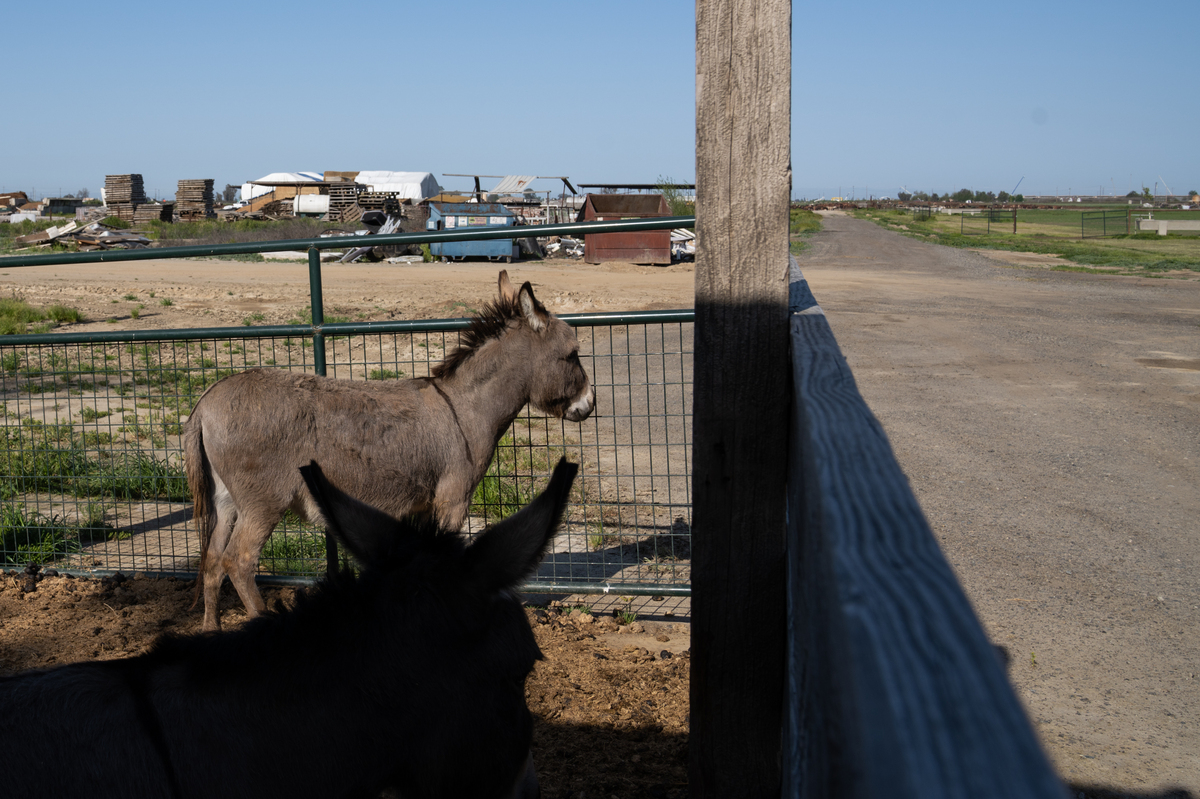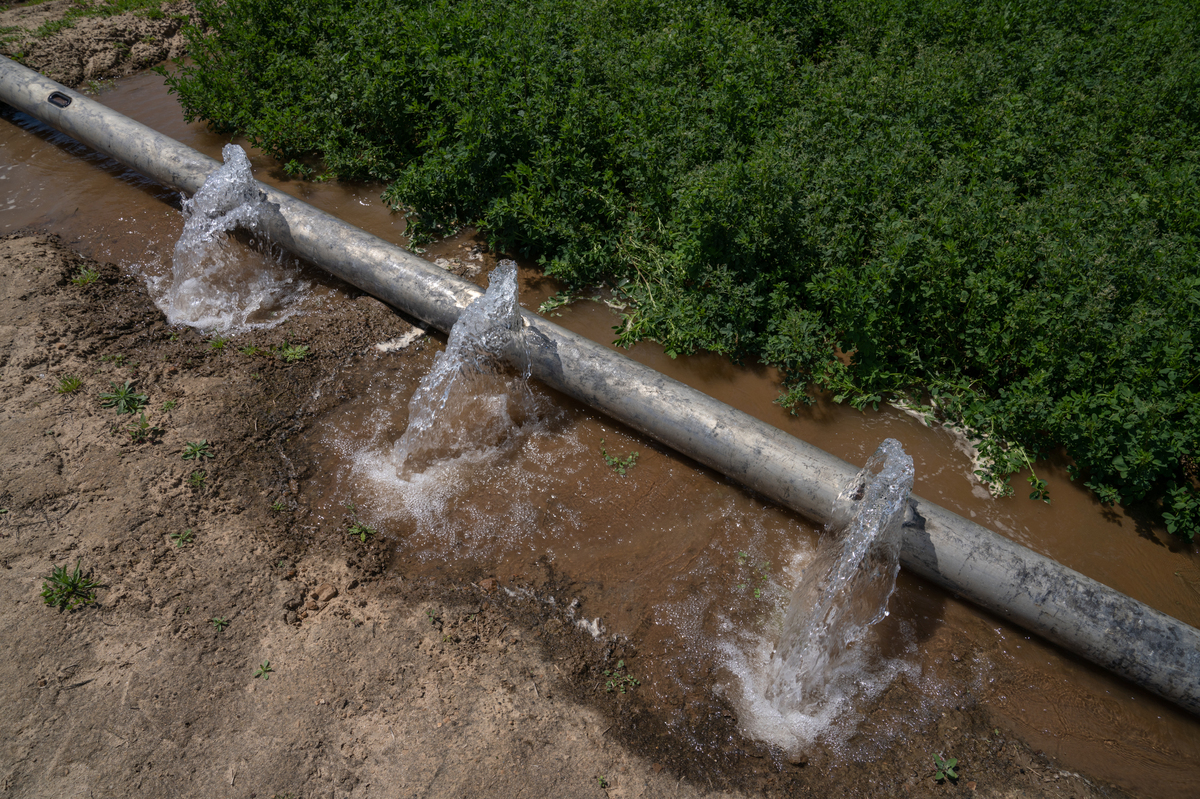Pipes direct water into an irrigation project held by the University of California. After a few decades of not enough water California water officials are scrambling to catch as much of this year’s floodwaters as they can.
Claire Harbage/NPR
hide caption
toggle caption
Claire Harbage/NPR


Pipes direct water into an irrigation project held by the University of California. After a few decades of not enough water California water officials are scrambling to catch as much of this year’s floodwaters as they can.
Claire Harbage/NPR
For much of the last few decades, when the sky didn’t produce enough water for his cows and crops, Dino Giacomazzi — like most farmers in California’s southern Central Valley — pumped it from the earth. Underground aquifers, vast bank accounts of stored water, were drained.
Now, after a historically wet winter, Giacomazzi and the state of California want to put some of that water back.
“It is a no-brainer, win-win, multi-benefit opportunity,” said Giacomazzi, standing on his Central Valley farm, which depends on groundwater to grow almonds, lettuce and tomatoes for pizza sauce.


Dino Giacomazzi stands on his Central Valley farm, which depends on groundwater to grow almonds, lettuce and tomatoes for pizza sauce.
Claire Harbage/NPR
hide caption
toggle caption
Claire Harbage/NPR


Dino Giacomazzi stands on his Central Valley farm, which depends on groundwater to grow almonds, lettuce and tomatoes for pizza sauce.
Claire Harbage/NPR
More water stored underground means fewer flooded farms, and more water available to farmers like him during the next inevitable drought.
An area nearly the size of New Orleans is already flooded downstream of Giacomzzi’s farm. State officials have warned more water is coming as warmer temperatures cause a record Sierra Nevada snowpack to melt. This week, however, they said some communities, such as Corcoran, should be safe from rising floodwaters because of levee improvements, favorable weather and efforts to spread the water upstream.


Giacomzzi’s donkeys look out over some of the land on his farm in the Central Valley.
Claire Harbage/NPR
hide caption
toggle caption
Claire Harbage/NPR


Giacomzzi’s donkeys look out over some of the land on his farm in the Central Valley.
Claire Harbage/NPR
But capturing the extra water is an opportunity that Giacomzzi worries is being missed.


Daniel Mounjoy (left), director of resource stewardship for Sustainable Conservation, a California-based nonprofit water group, talks with a colleague at a vineyard that is sinking water into the ground.
Claire Harbage/NPR
hide caption
toggle caption
Claire Harbage/NPR


Daniel Mounjoy (left), director of resource stewardship for Sustainable Conservation, a California-based nonprofit water group, talks with a colleague at a vineyard that is sinking water into the ground.
Claire Harbage/NPR
“The condition we find ourselves in right now is that there are billions of gallons of water just flowing right through us, right on by, and heading down and filling the Tulare Lake,” Giacomazzi said, referencing the long-dried lake — once the largest west of the Mississippi River — that’s come roaring back to life during this winter’s storms.


Water floods a field at an irrigation project run by the University of California.
Claire Harbage/NPR
hide caption
toggle caption
Claire Harbage/NPR


Water floods a field at an irrigation project run by the University of California.
Claire Harbage/NPR
California water officials are scrambling to catch as much of the floodwaters as they can. In January, as a series of atmospheric rivers blasted the state with rain and snow, the state’s Department of Water Resources announced it was accelerating permitting for projects that put water back into the aquifers.


Water is pumped into a vineyard, flooding the field. In some water districts, like Madera County’s, in the heart of the Central Valley, farmers are being incentivized to use their existing infrastructure to flood their fields with free or reduced cost water.
Claire Harbage/NPR
hide caption
toggle caption
Claire Harbage/NPR


Water is pumped into a vineyard, flooding the field. In some water districts, like Madera County’s, in the heart of the Central Valley, farmers are being incentivized to use their existing infrastructure to flood their fields with free or reduced cost water.
Claire Harbage/NPR
“Projects that capture available precipitation, stormwater, or floodwaters to recharge depleted groundwater basins need to be ready to capture high flows when they are available during each wet season,” said Karla Nemeth, the agency’s director.


Nick Davis stands in the vineyard that he owns with his twin brother outside of Madera. He’s been dumping water on his grape vines since the heavy rains started this winter, sinking more than 4 times the amount of water he typically uses on the vines into the ground.
Claire Harbage/NPR
hide caption
toggle caption
Claire Harbage/NPR


Nick Davis stands in the vineyard that he owns with his twin brother outside of Madera. He’s been dumping water on his grape vines since the heavy rains started this winter, sinking more than 4 times the amount of water he typically uses on the vines into the ground.
Claire Harbage/NPR
Two months later, California Gov. Gavin Newsom signed an executive order making it easier for farmers to divert water onto their lands.
But in some parts of the Central Valley, like Giacomazzi’s, bureaucracy, water rights and a history of over-pumping are creating roadblocks.
“The issue with these water systems in California is that every couple of miles in this state, it’s a completely different independently-operated situation,” Giacomazzi said. “There isn’t really a coordinating body that sits over the top if that says, ‘Here’s what we need to do. Let’s do it together.'”
A test for California’s climate future
California has always experienced dramatic swings from drought to floodwaters. Those swings are expected to become more severe as temperatures rise due to human-caused climate change.
In that sense, the situation playing out in California this year could be a window into the state’s climate future, said Daniel Mountjoy, director of resource stewardship for Sustainable Conservation, a California-based nonprofit water group.
“I’ve worked in water my entire career and one of our sayings is never waste a good crisis,” he said, standing next to a field of purposely flooded grape vines at a vineyard north of Fresno. “This is our chance for everyone to be aware of what’s possible.”
California water experts like Mountjoy, hydrologists and environmental watchdog groups have long warned the Central Valley’s use of groundwater was unsustainable. Parts of the southern Central Valley that are now flooded, have sunk by as much as 28 feet over the last few decades — deflated like a punctured balloon — because so much water has been pumped from the ground.
The state aimed to address the problem with legislation in 2014 that requires local water agencies to bring their underground accounts into balance.
“We’re going to have to put in as much as we pump out,” said Eric Holder, an irrigation research assistant with the University of California.
Cutting groundwater use could be painful. A study by the Public Policy Institute of California last year found that an estimated 500,000 acres of farmland would have to go unplanted in the southern Central Valley over the next 20 years to help restore water underground. That’s even with increased capturing of storm waters in a year like this. The region produces billions of dollars in almonds, pistachios, dairy and other produce every year.
“We’ve got to find a safe landing pattern,” Mountjoy said. “Come up with a way to reduce the pumping or increase the groundwater supply.”
Some farmers are flooding their fields
With so much of the state awash in water, the focus in California is on increasing groundwater supply — stashing more into the bank account — by flooding farmland.
In some areas, like Giacomazzi’s, there isn’t enough incentive for farmers to flood their fields, or the infrastructure doesn’t exist to divert water from canals and streams.
“It takes a lot of money to excavate a basin and build the structures to divert water off the system,” said Mark Larsen, general manager of the Kaweah Delta Water Conservation District. “And then you have it sitting [dry] most of the time waiting for a year like this.”
In some water districts, like Madera County’s, in the heart of the Central Valley, farmers are being incentivized to use their existing infrastructure to flood their fields with free or reduced cost water.
“That’s our way to motivate people to take that water, spread it and get that water in the ground when it’s available in years like this,” said Thomas Greci, general manager of the Madera Irrigation District.
Nick Davis, who owns a vineyard with his twin brother outside of Madera, has decided to participate. He’s been dumping water on his grape vines since the heavy rains started this winter, sinking more than 4 times the amount of water he typically uses on the vines into the ground.
“We’re all skeptical about trying new things,” Davis said. “But we feel it’s important to just do our part and put it back in the ground.”
He’s hopeful the state will give him credit for all of the water he’s returning to the aquifer, or pay him for the water that he’s deposited. Incentives like that, Davis said, would make other farmers think more seriously about flooding their fields in the current moment and in wet years to come.
“We understand that we are part of the problem,” Davis said. “But we also want to be part of the solution when it’s possible.”
This story originally appeared on NPR

